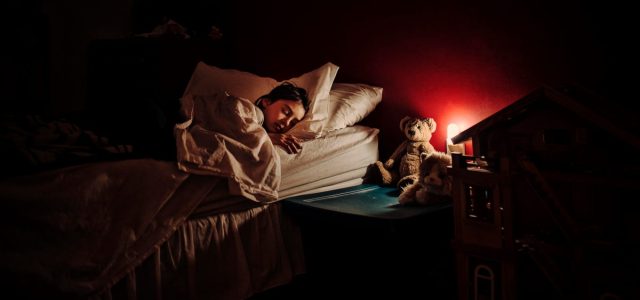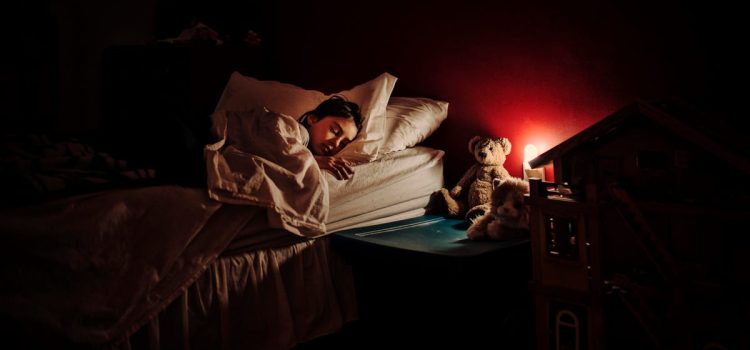


Darkness swirls.
The hairy legs of a tarantula crawl across your face. A slithering snake encircles your legs. Fins circle you, slowly getting closer and closer as you tread deep, murky water.
Your teeth fall from your mouth in a shower of enamel. You’re standing in front of a huge crowd in nothing but your underwear…
You wake up. Sweat covers your face, your heart thumps loudly in the dark of your room, and your disoriented senses scramble for equilibrium. You’re OK. You’re safe.
It was only a nightmare.
The stuff of nightmares
Nightmares can ruin your whole night. They’re invasive – vivid, terrifying dreams that condemn us to a late-night purgatory, half-asleep and shaken in the darkness. Terror and panic are common associates to the nightmare-plagued brain, which can linger as the mind reconciles its horrible dream experience with the sudden return to reality.
It’s not uncommon. According to Sleep Education, an estimated 50% to 85% of US adults report having occasional nightmares, with up to 5% of the US experiencing regular nightmares as a result of nightmare disorder. For the latter camp, consistent nocturnal episodes are a type of parasomnia, or disruptive sleep disorder. From sleep paralysis through to sleepwalking, parasomnias can have a much more serious effect on sleep quality and waking life.
But when these nightmares start to sabotage your quality of sleep and plague your mind within your waking hours, that’s when there’s cause for concern.
For over 10 years, psychology student Gemma Simpson has experienced disruptive nightmares that routinely affect her sleep and day-to-day life.
“Sleep is always worse straight after a nightmare,” she said. “They are always vivid, so I tend to marinate on them unintentionally over the next few days until the trauma fades a bit.”
She describes her nightmares as rarely sensical and largely traumatic, with violence and graphic experiences the norm. It can be incredibly confronting subject matter.
“I had a dream once that my dad beat me with an aluminum baseball bat in an art gallery,” she said. “The art gallery bit was very specific and strange. … I’ve also had nightmares about sexual assault and violence.”
As a psychology student, Simpson is well familiar with Freud’s theory of dreams, wherein they represent unconscious desires and feelings that the brain needs to process.
“All your memory consolidation happens in your sleep,” she said. “I think it’s most likely that the days I have nightmares I would have seen something that alerted me of my traumas, even if I hadn’t given it a second thought at the time.
According to sleep psychologist Dan Ford of Auckland’s Better Sleep Clinic, trying to interpret dreams once you’ve woken up can only be helpful if it makes you feel comforted.
“The general interpretation is, something’s not quite right, and that’s why you’re getting nightmares, so I’d probably stick at that kind of level,” he said. “Because what do you see with dreaming in general, right? It’s pretty nonsensical.”
“You might be spending your time on something that’s not really that important. If it’s something repetitive related to a trauma you’ve been through, there’s probably no interpretation required.”
Possible nightmare triggers
If you only get the occasional nightmare – maybe once a fortnight or so – it’s usually fairly easy to pinpoint why. Common nightmare triggers include:
- Stress
- Bad sleep hygiene
- Anxiety
- The adrenaline spike of a scary movie
- Illnesses (especially fever).
What is actually happening in your brain?
According to CNET sister site Healthline, the human brain generally cycles through four stages of sleep over the course of a night.
4 stages of sleep
These stages are distinguished by different brain and body activity, and signify the depth of sleep that the person is experiencing – typically measured via an electroencephalogram, or EEG.
- Stage one consists of the brain and body slowly settling into sleep – your heart rate regulates, your system begins to calm and it normally lasts for up to five minutes.
- Stage two is light sleep, where you’ve settled but haven’t quite sunk into the depth of sleep required to initiate tissue growth, system repairs and cell regeneration.
- Stage three is the deep sleep stage, known as slow wave sleep. In this, the body is fully relaxed, delta brain waves are present and there is no eye movement. Your body regenerates cells, your immune system strengthens and your heart rate is at its slowest.
- Stage four is what’s known as rapid eye movement sleep, or REM sleep. It’s here that you’re able to dream, with your brain activity escalating and your eyes moving rapidly. For most people, their limbs become paralyzed as they sleep.
It typically takes up to an hour and a half of sleep before you settle into REM sleep, so although it may feel like you’re dreaming as soon as your head hits the pillow, you likely aren’t.
“For the average person out there, that means nightmares will more likely happen in the second half of the night,” said Ford.
Nightmares will only occur in REM sleep, where the mind is at its most active. In people who don’t experience the limb paralysis element of stage four, this is also when they might sleepwalk or act out their dreams – though this is admittedly more rare. Others experience the paralysis without the sleeping part, which can be terrifying in its own way.
“Essentially what we’re doing is we’re processing emotion,” said Ford, “What we’re probably seeing is someone who is potentially hyper aroused, so their arousal levels or sympathetic nervous system is triggered or activated, and so that’s then bleeding into their sleep and into the nightmares.”
Nightmares versus night terrors
Though similar in name, nightmares and night terrors are not interchangeable experiences.
When I was a teenager, I did a lot of babysitting. One night, I was covering a friend’s babysitting shift with a new family. The night seemed fine, until they went to bed. After forty minutes of sleep, the 9-year-old child came screaming out of the bedroom with no warning.
His eyes were wide open, staring at me intently as he continued to emit blood-curdling screams. Though it didn’t seem like it, he was still asleep.
What the parents hadn’t warned me of before they left was that their child often experiences night terrors, which are distinctly separate from nightmares and are associated with confusion, screaming and other vocalizations.
“They’re both parasomnias, however they happen in different phases of sleep,” said Ford. “So night terrors generally will happen in non-dream sleep, or non-REM sleep, and nightmares will happen predominantly in REM sleep.”
This means that night terrors usually occur earlier in the sleep cycle. Night terrors are predominantly experienced by children between the ages of 4 and 12, and are usually something that children simply grow out of.
One of the key differences between nightmare disorders and night terrors is the lack of recollection. In a sleeper who wakes from a bad dream, they’ll generally have an abstract recollection of the most notable features of their dream – maybe a particularly scary figure or feeling – whereas those afflicted with night terrors tend to wake up not having any recollection of their experience at all.
As a result, night terrors can be far more distressing for those around the sleeper. For parents, hearing your child scream in the middle of the night is the stuff horror movies are made of.
Nightmare on every street
One, two, Freddy’s coming for you.
In the world of cinema, a nightmare is synonymous with danger. From Nightmare on Elm Street through to the Boogeyman, these movies have not only solidified their place in pop culture, but often been targeted as the reasoning behind real-world nightmares.
Healthline suggests that if you’re susceptible to internalizing sensitive material, you may not be the best candidate to watch horror films because of the effect they may have on your sleep and mental health. But some people absolutely adore the thrill and fear of the genre – so which is it, really?
From a psychological perspective, horror movies and thrillers stimulate the production of adrenaline in a controlled environment – one that rests in the hands of the viewer to initiate, but also to put a stop to.
“One of the criteria for diagnosis is that the nightmare is some sort of threat to your physical integrity. So in that sense, the nightmare content is very threatening to the person having it,” said Ford.
The issue is that with the advent of better technology and effects, the films look more realistic and threatening than ever before – even when we’re watching fantasy creatures like zombies and monsters.
If you’re someone who experiences mental health concerns like anxiety, depression and especially PTSD, the experience of viewing a horror film can certainly contribute to your chances of having a nightmare.
“I tend to steer clear of the horror films where it is people doing the horror,” said Simpson. “If it’s fantasy creatures then I’m usually good, but as a general rule I don’t really watch horror because of the likelihood of nightmares.”
“My brain is like, ‘I know monsters and aliens (probably) aren’t real,’ so I can justify it, but if it’s people it’s just a little too realistic.”
Elizabeth Olsen stars in Marvel’s Doctor Strange in the Multiverse of Madness.
With that being the case, it’s little wonder nightmares have cemented such a basis in horror and thriller pop culture – the fight-or-flight reflex triggered by horror movies is the same reflex we feel when we awake from a nightmare that threatens our physical integrity.
But for many, watching nightmares play out on film, generally with a happy ending, can feel like a safer, controlled alternative.
One of the most comforting, if disconcerting, ideas of nightmares in pop culture comes from Marvel’s Doctor Strange in the Multiverse of Madness. The movie posits that when you dream, you’re experiencing a window into the life you lead in an alternate universe.
In doing so, it suggests that all dreams and nightmares could be windows into the multiverse – abstract universes with different rules, experiences and modalities. Despite no scientific backing, the recent multiverse trend makes it a theory that offers some comfort.
So, next time you have a severe nightmare, consider that maybe somewhere – in some universe – there’s a version of you who’s stuck facing down a 12-foot tarantula while dressed in your underwear.
But it’s not you.
It’s just a dream.
